Tourism and Hospitality Research Trends
VerifiedAdded on 2020/01/28
|15
|5112
|93
Literature Review
AI Summary
This assignment presents a compilation of academic papers exploring various facets of tourism and hospitality. Topics covered include disruptive innovation in accommodation (Airbnb), the resilience of dive tourism, Chinese outbound tourism, economic impacts of tourism, travel experiences, destination image perception, hotel performance, and forecasting tourist volume using search engine data.
Contribute Materials
Your contribution can guide someone’s learning journey. Share your
documents today.
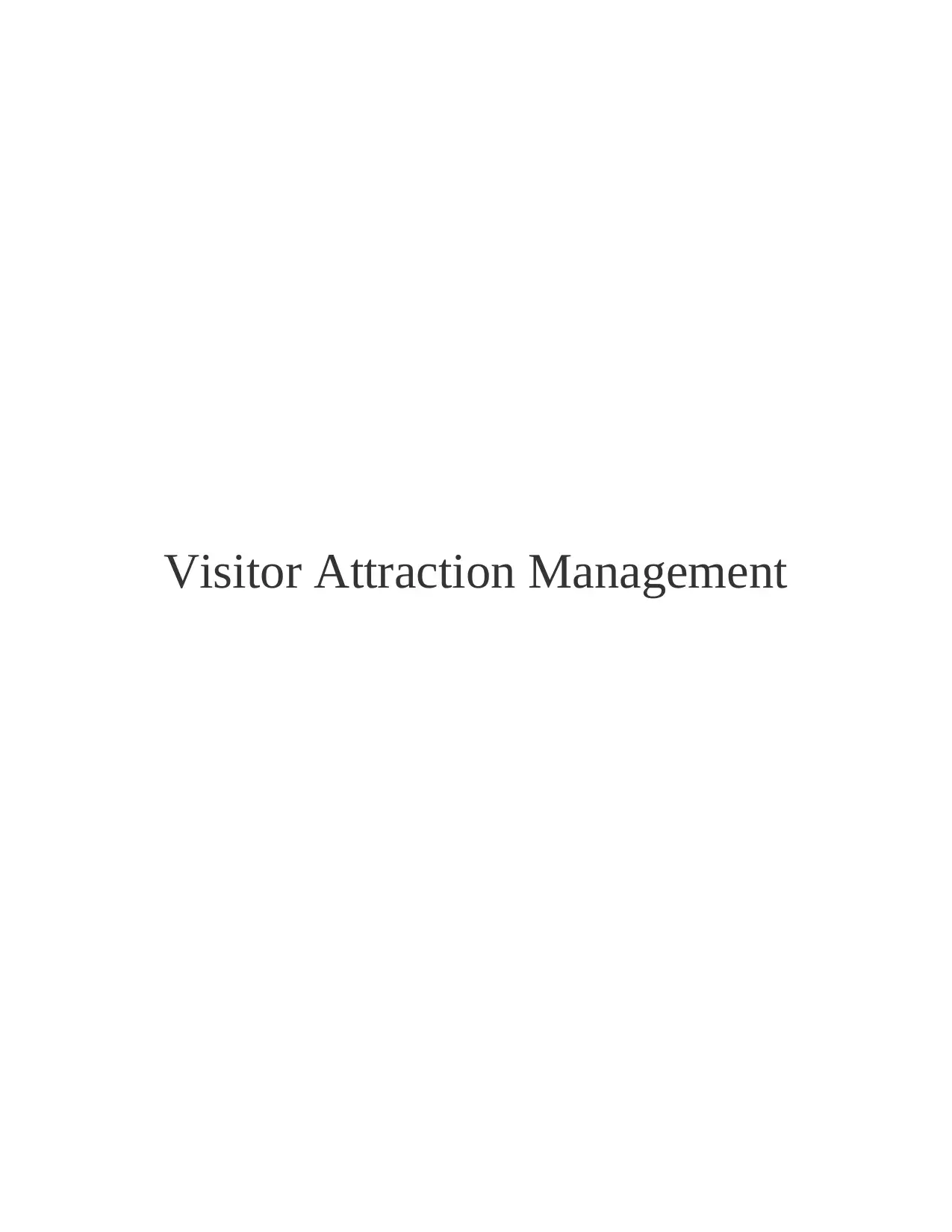
Visitor Attraction Management
Secure Best Marks with AI Grader
Need help grading? Try our AI Grader for instant feedback on your assignments.
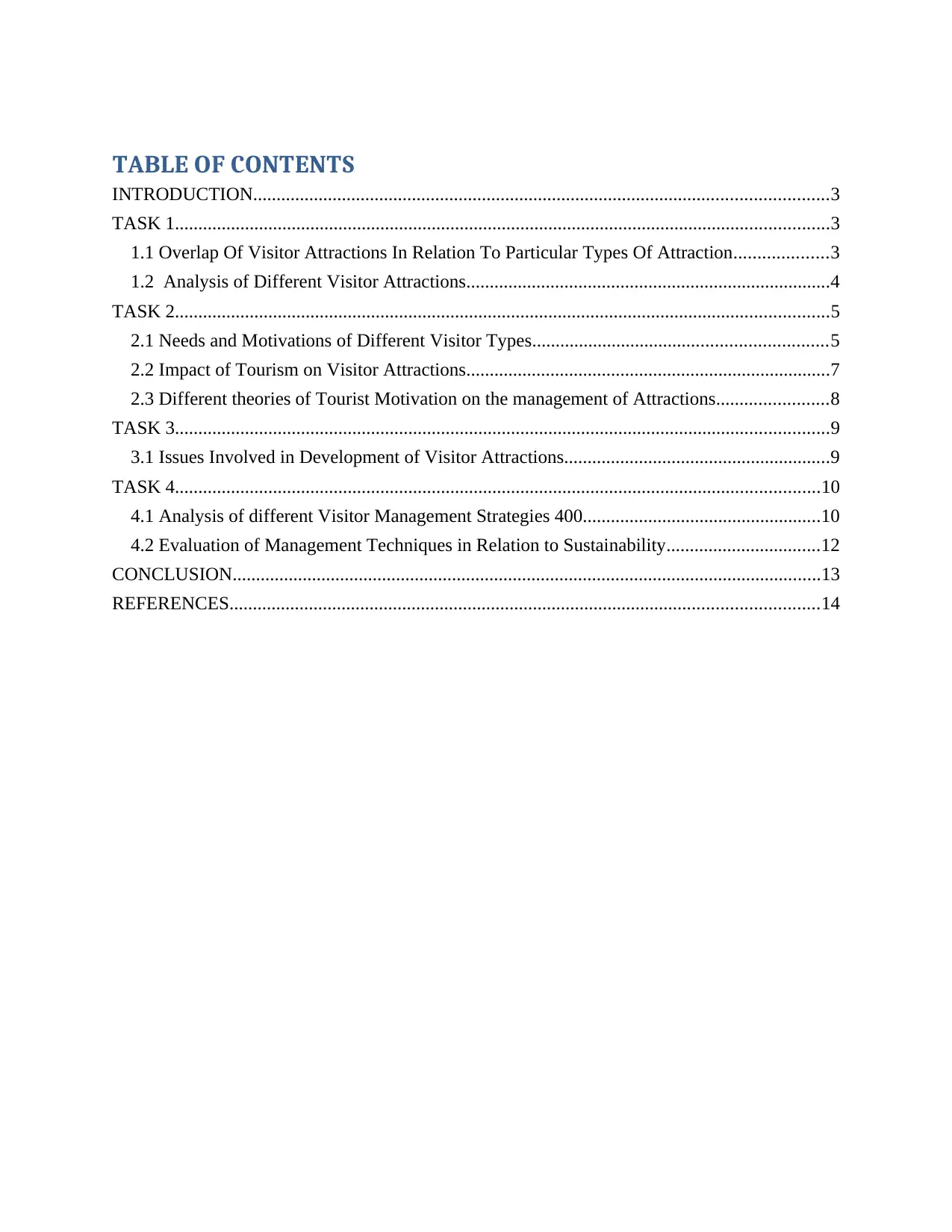
TABLE OF CONTENTS
INTRODUCTION...........................................................................................................................3
TASK 1............................................................................................................................................3
1.1 Overlap Of Visitor Attractions In Relation To Particular Types Of Attraction....................3
1.2 Analysis of Different Visitor Attractions..............................................................................4
TASK 2............................................................................................................................................5
2.1 Needs and Motivations of Different Visitor Types...............................................................5
2.2 Impact of Tourism on Visitor Attractions..............................................................................7
2.3 Different theories of Tourist Motivation on the management of Attractions........................8
TASK 3............................................................................................................................................9
3.1 Issues Involved in Development of Visitor Attractions.........................................................9
TASK 4..........................................................................................................................................10
4.1 Analysis of different Visitor Management Strategies 400...................................................10
4.2 Evaluation of Management Techniques in Relation to Sustainability.................................12
CONCLUSION..............................................................................................................................13
REFERENCES..............................................................................................................................14
INTRODUCTION...........................................................................................................................3
TASK 1............................................................................................................................................3
1.1 Overlap Of Visitor Attractions In Relation To Particular Types Of Attraction....................3
1.2 Analysis of Different Visitor Attractions..............................................................................4
TASK 2............................................................................................................................................5
2.1 Needs and Motivations of Different Visitor Types...............................................................5
2.2 Impact of Tourism on Visitor Attractions..............................................................................7
2.3 Different theories of Tourist Motivation on the management of Attractions........................8
TASK 3............................................................................................................................................9
3.1 Issues Involved in Development of Visitor Attractions.........................................................9
TASK 4..........................................................................................................................................10
4.1 Analysis of different Visitor Management Strategies 400...................................................10
4.2 Evaluation of Management Techniques in Relation to Sustainability.................................12
CONCLUSION..............................................................................................................................13
REFERENCES..............................................................................................................................14
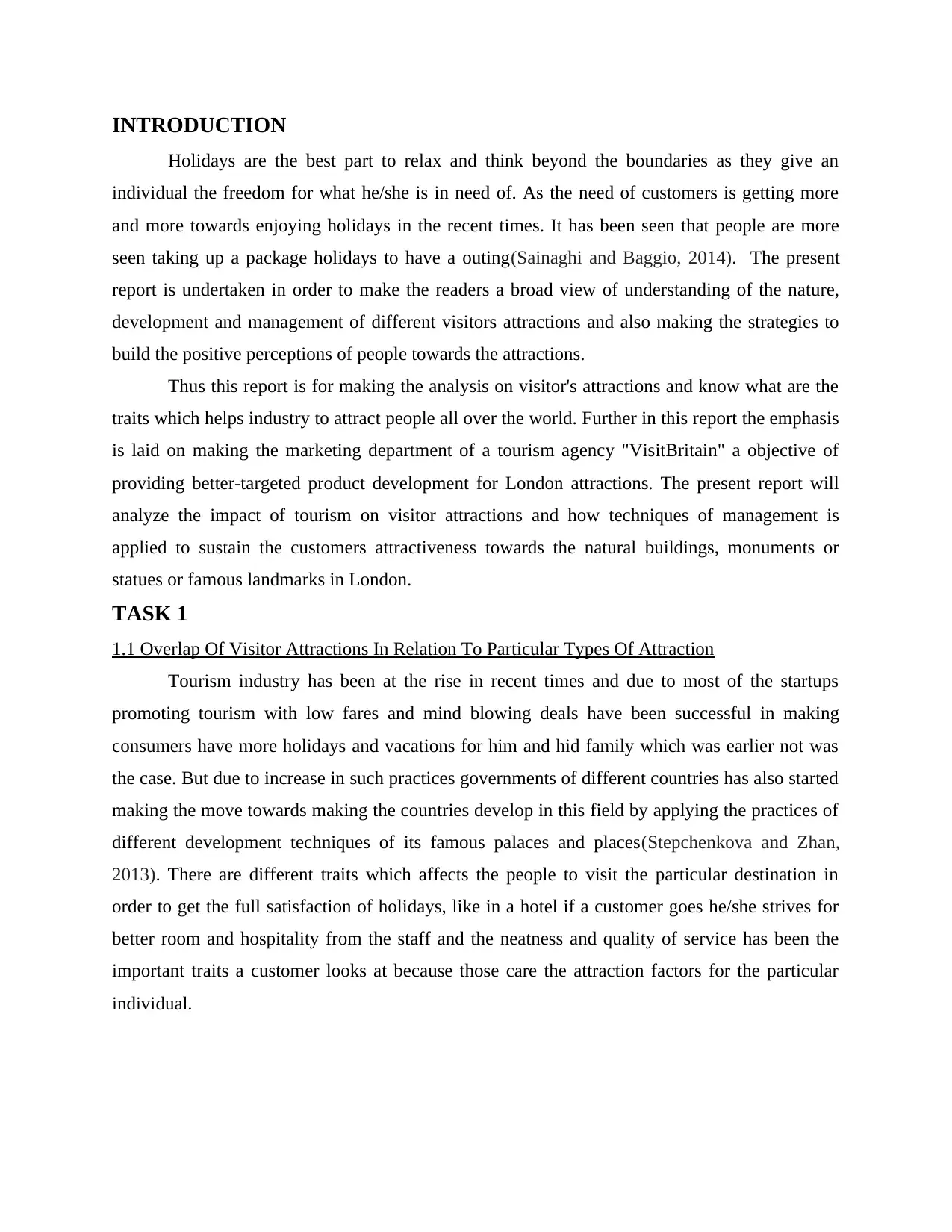
INTRODUCTION
Holidays are the best part to relax and think beyond the boundaries as they give an
individual the freedom for what he/she is in need of. As the need of customers is getting more
and more towards enjoying holidays in the recent times. It has been seen that people are more
seen taking up a package holidays to have a outing(Sainaghi and Baggio, 2014). The present
report is undertaken in order to make the readers a broad view of understanding of the nature,
development and management of different visitors attractions and also making the strategies to
build the positive perceptions of people towards the attractions.
Thus this report is for making the analysis on visitor's attractions and know what are the
traits which helps industry to attract people all over the world. Further in this report the emphasis
is laid on making the marketing department of a tourism agency "VisitBritain" a objective of
providing better-targeted product development for London attractions. The present report will
analyze the impact of tourism on visitor attractions and how techniques of management is
applied to sustain the customers attractiveness towards the natural buildings, monuments or
statues or famous landmarks in London.
TASK 1
1.1 Overlap Of Visitor Attractions In Relation To Particular Types Of Attraction
Tourism industry has been at the rise in recent times and due to most of the startups
promoting tourism with low fares and mind blowing deals have been successful in making
consumers have more holidays and vacations for him and hid family which was earlier not was
the case. But due to increase in such practices governments of different countries has also started
making the move towards making the countries develop in this field by applying the practices of
different development techniques of its famous palaces and places(Stepchenkova and Zhan,
2013). There are different traits which affects the people to visit the particular destination in
order to get the full satisfaction of holidays, like in a hotel if a customer goes he/she strives for
better room and hospitality from the staff and the neatness and quality of service has been the
important traits a customer looks at because those care the attraction factors for the particular
individual.
Holidays are the best part to relax and think beyond the boundaries as they give an
individual the freedom for what he/she is in need of. As the need of customers is getting more
and more towards enjoying holidays in the recent times. It has been seen that people are more
seen taking up a package holidays to have a outing(Sainaghi and Baggio, 2014). The present
report is undertaken in order to make the readers a broad view of understanding of the nature,
development and management of different visitors attractions and also making the strategies to
build the positive perceptions of people towards the attractions.
Thus this report is for making the analysis on visitor's attractions and know what are the
traits which helps industry to attract people all over the world. Further in this report the emphasis
is laid on making the marketing department of a tourism agency "VisitBritain" a objective of
providing better-targeted product development for London attractions. The present report will
analyze the impact of tourism on visitor attractions and how techniques of management is
applied to sustain the customers attractiveness towards the natural buildings, monuments or
statues or famous landmarks in London.
TASK 1
1.1 Overlap Of Visitor Attractions In Relation To Particular Types Of Attraction
Tourism industry has been at the rise in recent times and due to most of the startups
promoting tourism with low fares and mind blowing deals have been successful in making
consumers have more holidays and vacations for him and hid family which was earlier not was
the case. But due to increase in such practices governments of different countries has also started
making the move towards making the countries develop in this field by applying the practices of
different development techniques of its famous palaces and places(Stepchenkova and Zhan,
2013). There are different traits which affects the people to visit the particular destination in
order to get the full satisfaction of holidays, like in a hotel if a customer goes he/she strives for
better room and hospitality from the staff and the neatness and quality of service has been the
important traits a customer looks at because those care the attraction factors for the particular
individual.
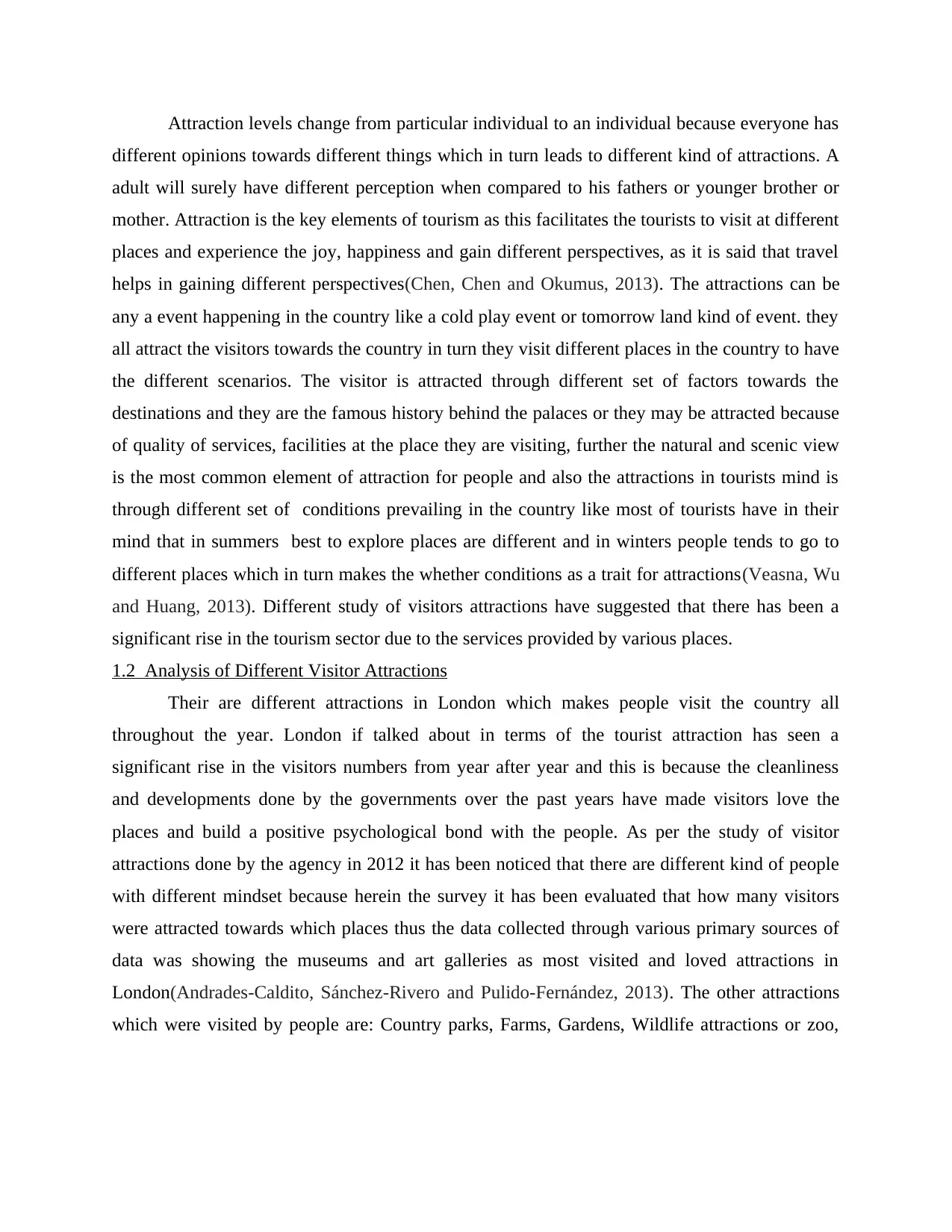
Attraction levels change from particular individual to an individual because everyone has
different opinions towards different things which in turn leads to different kind of attractions. A
adult will surely have different perception when compared to his fathers or younger brother or
mother. Attraction is the key elements of tourism as this facilitates the tourists to visit at different
places and experience the joy, happiness and gain different perspectives, as it is said that travel
helps in gaining different perspectives(Chen, Chen and Okumus, 2013). The attractions can be
any a event happening in the country like a cold play event or tomorrow land kind of event. they
all attract the visitors towards the country in turn they visit different places in the country to have
the different scenarios. The visitor is attracted through different set of factors towards the
destinations and they are the famous history behind the palaces or they may be attracted because
of quality of services, facilities at the place they are visiting, further the natural and scenic view
is the most common element of attraction for people and also the attractions in tourists mind is
through different set of conditions prevailing in the country like most of tourists have in their
mind that in summers best to explore places are different and in winters people tends to go to
different places which in turn makes the whether conditions as a trait for attractions(Veasna, Wu
and Huang, 2013). Different study of visitors attractions have suggested that there has been a
significant rise in the tourism sector due to the services provided by various places.
1.2 Analysis of Different Visitor Attractions
Their are different attractions in London which makes people visit the country all
throughout the year. London if talked about in terms of the tourist attraction has seen a
significant rise in the visitors numbers from year after year and this is because the cleanliness
and developments done by the governments over the past years have made visitors love the
places and build a positive psychological bond with the people. As per the study of visitor
attractions done by the agency in 2012 it has been noticed that there are different kind of people
with different mindset because herein the survey it has been evaluated that how many visitors
were attracted towards which places thus the data collected through various primary sources of
data was showing the museums and art galleries as most visited and loved attractions in
London(Andrades-Caldito, Sánchez-Rivero and Pulido-Fernández, 2013). The other attractions
which were visited by people are: Country parks, Farms, Gardens, Wildlife attractions or zoo,
different opinions towards different things which in turn leads to different kind of attractions. A
adult will surely have different perception when compared to his fathers or younger brother or
mother. Attraction is the key elements of tourism as this facilitates the tourists to visit at different
places and experience the joy, happiness and gain different perspectives, as it is said that travel
helps in gaining different perspectives(Chen, Chen and Okumus, 2013). The attractions can be
any a event happening in the country like a cold play event or tomorrow land kind of event. they
all attract the visitors towards the country in turn they visit different places in the country to have
the different scenarios. The visitor is attracted through different set of factors towards the
destinations and they are the famous history behind the palaces or they may be attracted because
of quality of services, facilities at the place they are visiting, further the natural and scenic view
is the most common element of attraction for people and also the attractions in tourists mind is
through different set of conditions prevailing in the country like most of tourists have in their
mind that in summers best to explore places are different and in winters people tends to go to
different places which in turn makes the whether conditions as a trait for attractions(Veasna, Wu
and Huang, 2013). Different study of visitors attractions have suggested that there has been a
significant rise in the tourism sector due to the services provided by various places.
1.2 Analysis of Different Visitor Attractions
Their are different attractions in London which makes people visit the country all
throughout the year. London if talked about in terms of the tourist attraction has seen a
significant rise in the visitors numbers from year after year and this is because the cleanliness
and developments done by the governments over the past years have made visitors love the
places and build a positive psychological bond with the people. As per the study of visitor
attractions done by the agency in 2012 it has been noticed that there are different kind of people
with different mindset because herein the survey it has been evaluated that how many visitors
were attracted towards which places thus the data collected through various primary sources of
data was showing the museums and art galleries as most visited and loved attractions in
London(Andrades-Caldito, Sánchez-Rivero and Pulido-Fernández, 2013). The other attractions
which were visited by people are: Country parks, Farms, Gardens, Wildlife attractions or zoo,
Secure Best Marks with AI Grader
Need help grading? Try our AI Grader for instant feedback on your assignments.
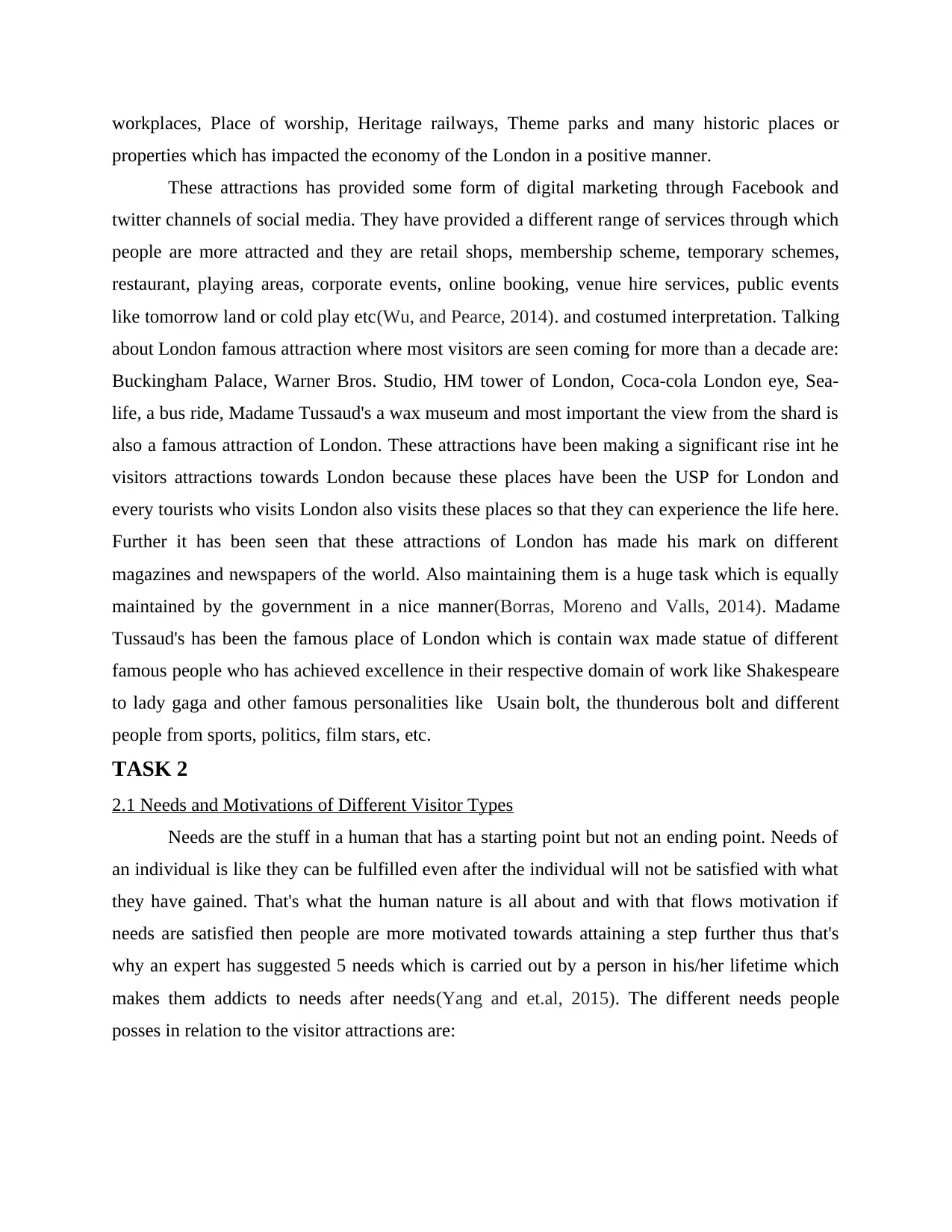
workplaces, Place of worship, Heritage railways, Theme parks and many historic places or
properties which has impacted the economy of the London in a positive manner.
These attractions has provided some form of digital marketing through Facebook and
twitter channels of social media. They have provided a different range of services through which
people are more attracted and they are retail shops, membership scheme, temporary schemes,
restaurant, playing areas, corporate events, online booking, venue hire services, public events
like tomorrow land or cold play etc(Wu, and Pearce, 2014). and costumed interpretation. Talking
about London famous attraction where most visitors are seen coming for more than a decade are:
Buckingham Palace, Warner Bros. Studio, HM tower of London, Coca-cola London eye, Sea-
life, a bus ride, Madame Tussaud's a wax museum and most important the view from the shard is
also a famous attraction of London. These attractions have been making a significant rise int he
visitors attractions towards London because these places have been the USP for London and
every tourists who visits London also visits these places so that they can experience the life here.
Further it has been seen that these attractions of London has made his mark on different
magazines and newspapers of the world. Also maintaining them is a huge task which is equally
maintained by the government in a nice manner(Borras, Moreno and Valls, 2014). Madame
Tussaud's has been the famous place of London which is contain wax made statue of different
famous people who has achieved excellence in their respective domain of work like Shakespeare
to lady gaga and other famous personalities like Usain bolt, the thunderous bolt and different
people from sports, politics, film stars, etc.
TASK 2
2.1 Needs and Motivations of Different Visitor Types
Needs are the stuff in a human that has a starting point but not an ending point. Needs of
an individual is like they can be fulfilled even after the individual will not be satisfied with what
they have gained. That's what the human nature is all about and with that flows motivation if
needs are satisfied then people are more motivated towards attaining a step further thus that's
why an expert has suggested 5 needs which is carried out by a person in his/her lifetime which
makes them addicts to needs after needs(Yang and et.al, 2015). The different needs people
posses in relation to the visitor attractions are:
properties which has impacted the economy of the London in a positive manner.
These attractions has provided some form of digital marketing through Facebook and
twitter channels of social media. They have provided a different range of services through which
people are more attracted and they are retail shops, membership scheme, temporary schemes,
restaurant, playing areas, corporate events, online booking, venue hire services, public events
like tomorrow land or cold play etc(Wu, and Pearce, 2014). and costumed interpretation. Talking
about London famous attraction where most visitors are seen coming for more than a decade are:
Buckingham Palace, Warner Bros. Studio, HM tower of London, Coca-cola London eye, Sea-
life, a bus ride, Madame Tussaud's a wax museum and most important the view from the shard is
also a famous attraction of London. These attractions have been making a significant rise int he
visitors attractions towards London because these places have been the USP for London and
every tourists who visits London also visits these places so that they can experience the life here.
Further it has been seen that these attractions of London has made his mark on different
magazines and newspapers of the world. Also maintaining them is a huge task which is equally
maintained by the government in a nice manner(Borras, Moreno and Valls, 2014). Madame
Tussaud's has been the famous place of London which is contain wax made statue of different
famous people who has achieved excellence in their respective domain of work like Shakespeare
to lady gaga and other famous personalities like Usain bolt, the thunderous bolt and different
people from sports, politics, film stars, etc.
TASK 2
2.1 Needs and Motivations of Different Visitor Types
Needs are the stuff in a human that has a starting point but not an ending point. Needs of
an individual is like they can be fulfilled even after the individual will not be satisfied with what
they have gained. That's what the human nature is all about and with that flows motivation if
needs are satisfied then people are more motivated towards attaining a step further thus that's
why an expert has suggested 5 needs which is carried out by a person in his/her lifetime which
makes them addicts to needs after needs(Yang and et.al, 2015). The different needs people
posses in relation to the visitor attractions are:
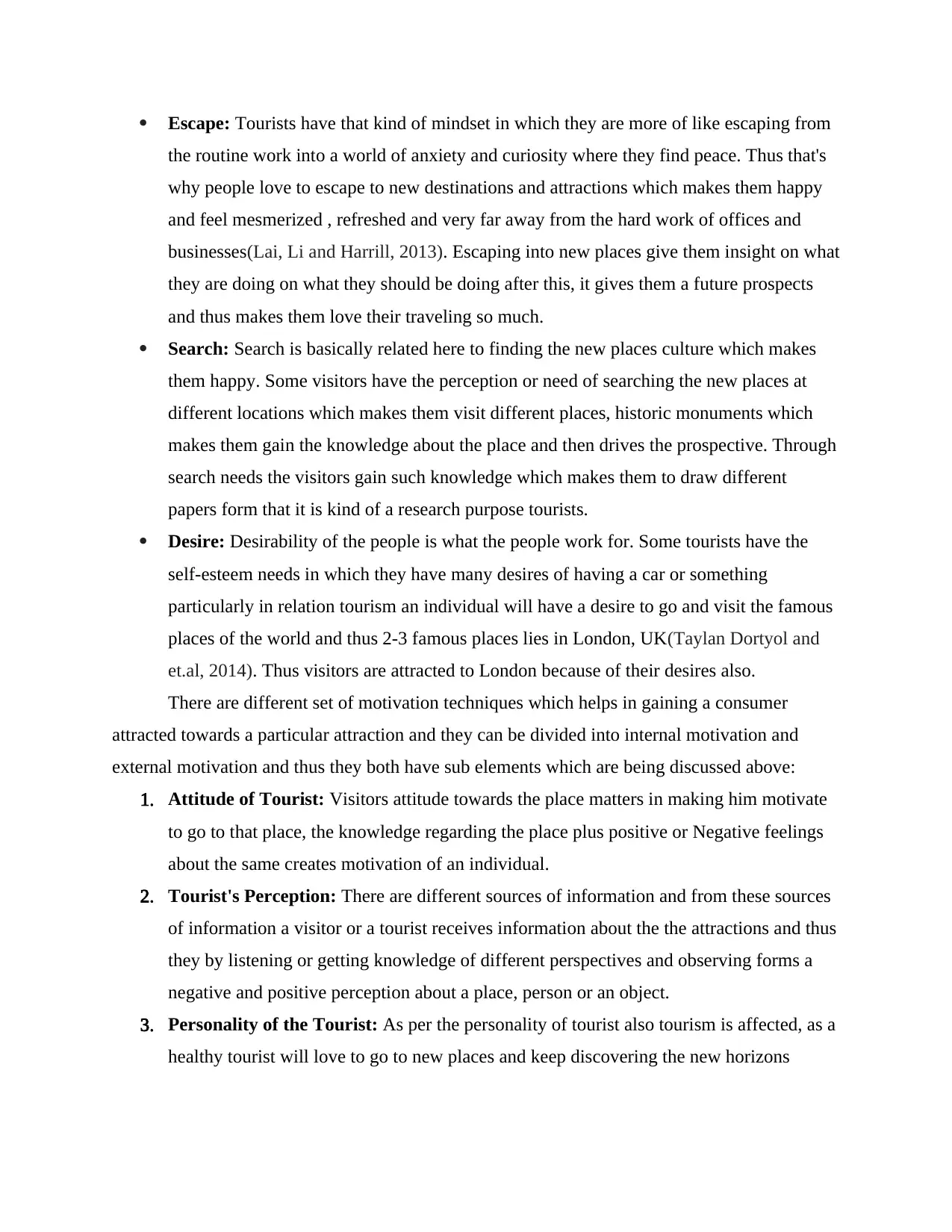
Escape: Tourists have that kind of mindset in which they are more of like escaping from
the routine work into a world of anxiety and curiosity where they find peace. Thus that's
why people love to escape to new destinations and attractions which makes them happy
and feel mesmerized , refreshed and very far away from the hard work of offices and
businesses(Lai, Li and Harrill, 2013). Escaping into new places give them insight on what
they are doing on what they should be doing after this, it gives them a future prospects
and thus makes them love their traveling so much.
Search: Search is basically related here to finding the new places culture which makes
them happy. Some visitors have the perception or need of searching the new places at
different locations which makes them visit different places, historic monuments which
makes them gain the knowledge about the place and then drives the prospective. Through
search needs the visitors gain such knowledge which makes them to draw different
papers form that it is kind of a research purpose tourists.
Desire: Desirability of the people is what the people work for. Some tourists have the
self-esteem needs in which they have many desires of having a car or something
particularly in relation tourism an individual will have a desire to go and visit the famous
places of the world and thus 2-3 famous places lies in London, UK(Taylan Dortyol and
et.al, 2014). Thus visitors are attracted to London because of their desires also.
There are different set of motivation techniques which helps in gaining a consumer
attracted towards a particular attraction and they can be divided into internal motivation and
external motivation and thus they both have sub elements which are being discussed above:
1. Attitude of Tourist: Visitors attitude towards the place matters in making him motivate
to go to that place, the knowledge regarding the place plus positive or Negative feelings
about the same creates motivation of an individual.
2. Tourist's Perception: There are different sources of information and from these sources
of information a visitor or a tourist receives information about the the attractions and thus
they by listening or getting knowledge of different perspectives and observing forms a
negative and positive perception about a place, person or an object.
3. Personality of the Tourist: As per the personality of tourist also tourism is affected, as a
healthy tourist will love to go to new places and keep discovering the new horizons
the routine work into a world of anxiety and curiosity where they find peace. Thus that's
why people love to escape to new destinations and attractions which makes them happy
and feel mesmerized , refreshed and very far away from the hard work of offices and
businesses(Lai, Li and Harrill, 2013). Escaping into new places give them insight on what
they are doing on what they should be doing after this, it gives them a future prospects
and thus makes them love their traveling so much.
Search: Search is basically related here to finding the new places culture which makes
them happy. Some visitors have the perception or need of searching the new places at
different locations which makes them visit different places, historic monuments which
makes them gain the knowledge about the place and then drives the prospective. Through
search needs the visitors gain such knowledge which makes them to draw different
papers form that it is kind of a research purpose tourists.
Desire: Desirability of the people is what the people work for. Some tourists have the
self-esteem needs in which they have many desires of having a car or something
particularly in relation tourism an individual will have a desire to go and visit the famous
places of the world and thus 2-3 famous places lies in London, UK(Taylan Dortyol and
et.al, 2014). Thus visitors are attracted to London because of their desires also.
There are different set of motivation techniques which helps in gaining a consumer
attracted towards a particular attraction and they can be divided into internal motivation and
external motivation and thus they both have sub elements which are being discussed above:
1. Attitude of Tourist: Visitors attitude towards the place matters in making him motivate
to go to that place, the knowledge regarding the place plus positive or Negative feelings
about the same creates motivation of an individual.
2. Tourist's Perception: There are different sources of information and from these sources
of information a visitor or a tourist receives information about the the attractions and thus
they by listening or getting knowledge of different perspectives and observing forms a
negative and positive perception about a place, person or an object.
3. Personality of the Tourist: As per the personality of tourist also tourism is affected, as a
healthy tourist will love to go to new places and keep discovering the new horizons
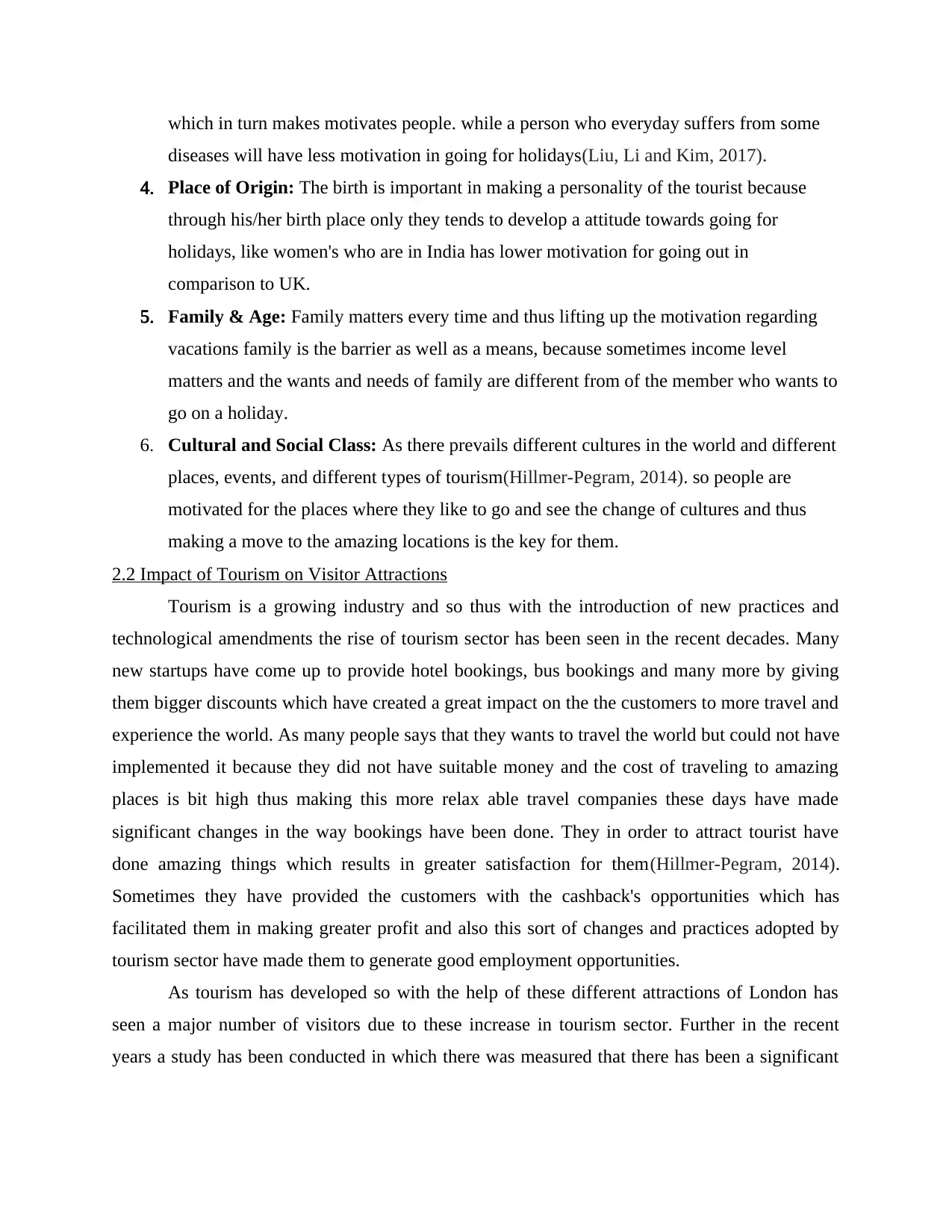
which in turn makes motivates people. while a person who everyday suffers from some
diseases will have less motivation in going for holidays(Liu, Li and Kim, 2017).
4. Place of Origin: The birth is important in making a personality of the tourist because
through his/her birth place only they tends to develop a attitude towards going for
holidays, like women's who are in India has lower motivation for going out in
comparison to UK.
5. Family & Age: Family matters every time and thus lifting up the motivation regarding
vacations family is the barrier as well as a means, because sometimes income level
matters and the wants and needs of family are different from of the member who wants to
go on a holiday.
6. Cultural and Social Class: As there prevails different cultures in the world and different
places, events, and different types of tourism(Hillmer-Pegram, 2014). so people are
motivated for the places where they like to go and see the change of cultures and thus
making a move to the amazing locations is the key for them.
2.2 Impact of Tourism on Visitor Attractions
Tourism is a growing industry and so thus with the introduction of new practices and
technological amendments the rise of tourism sector has been seen in the recent decades. Many
new startups have come up to provide hotel bookings, bus bookings and many more by giving
them bigger discounts which have created a great impact on the the customers to more travel and
experience the world. As many people says that they wants to travel the world but could not have
implemented it because they did not have suitable money and the cost of traveling to amazing
places is bit high thus making this more relax able travel companies these days have made
significant changes in the way bookings have been done. They in order to attract tourist have
done amazing things which results in greater satisfaction for them(Hillmer-Pegram, 2014).
Sometimes they have provided the customers with the cashback's opportunities which has
facilitated them in making greater profit and also this sort of changes and practices adopted by
tourism sector have made them to generate good employment opportunities.
As tourism has developed so with the help of these different attractions of London has
seen a major number of visitors due to these increase in tourism sector. Further in the recent
years a study has been conducted in which there was measured that there has been a significant
diseases will have less motivation in going for holidays(Liu, Li and Kim, 2017).
4. Place of Origin: The birth is important in making a personality of the tourist because
through his/her birth place only they tends to develop a attitude towards going for
holidays, like women's who are in India has lower motivation for going out in
comparison to UK.
5. Family & Age: Family matters every time and thus lifting up the motivation regarding
vacations family is the barrier as well as a means, because sometimes income level
matters and the wants and needs of family are different from of the member who wants to
go on a holiday.
6. Cultural and Social Class: As there prevails different cultures in the world and different
places, events, and different types of tourism(Hillmer-Pegram, 2014). so people are
motivated for the places where they like to go and see the change of cultures and thus
making a move to the amazing locations is the key for them.
2.2 Impact of Tourism on Visitor Attractions
Tourism is a growing industry and so thus with the introduction of new practices and
technological amendments the rise of tourism sector has been seen in the recent decades. Many
new startups have come up to provide hotel bookings, bus bookings and many more by giving
them bigger discounts which have created a great impact on the the customers to more travel and
experience the world. As many people says that they wants to travel the world but could not have
implemented it because they did not have suitable money and the cost of traveling to amazing
places is bit high thus making this more relax able travel companies these days have made
significant changes in the way bookings have been done. They in order to attract tourist have
done amazing things which results in greater satisfaction for them(Hillmer-Pegram, 2014).
Sometimes they have provided the customers with the cashback's opportunities which has
facilitated them in making greater profit and also this sort of changes and practices adopted by
tourism sector have made them to generate good employment opportunities.
As tourism has developed so with the help of these different attractions of London has
seen a major number of visitors due to these increase in tourism sector. Further in the recent
years a study has been conducted in which there was measured that there has been a significant
Paraphrase This Document
Need a fresh take? Get an instant paraphrase of this document with our AI Paraphraser
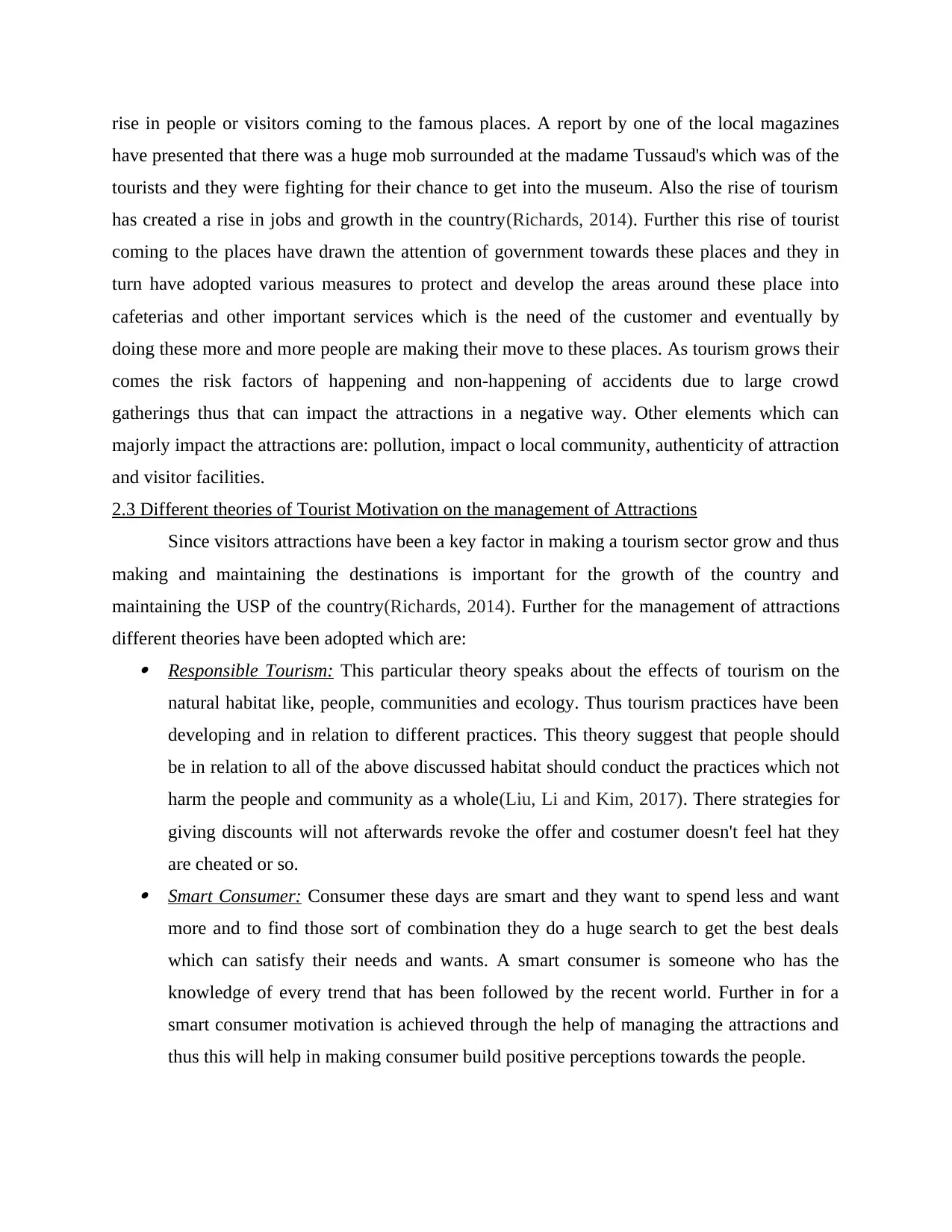
rise in people or visitors coming to the famous places. A report by one of the local magazines
have presented that there was a huge mob surrounded at the madame Tussaud's which was of the
tourists and they were fighting for their chance to get into the museum. Also the rise of tourism
has created a rise in jobs and growth in the country(Richards, 2014). Further this rise of tourist
coming to the places have drawn the attention of government towards these places and they in
turn have adopted various measures to protect and develop the areas around these place into
cafeterias and other important services which is the need of the customer and eventually by
doing these more and more people are making their move to these places. As tourism grows their
comes the risk factors of happening and non-happening of accidents due to large crowd
gatherings thus that can impact the attractions in a negative way. Other elements which can
majorly impact the attractions are: pollution, impact o local community, authenticity of attraction
and visitor facilities.
2.3 Different theories of Tourist Motivation on the management of Attractions
Since visitors attractions have been a key factor in making a tourism sector grow and thus
making and maintaining the destinations is important for the growth of the country and
maintaining the USP of the country(Richards, 2014). Further for the management of attractions
different theories have been adopted which are: Responsible Tourism: This particular theory speaks about the effects of tourism on the
natural habitat like, people, communities and ecology. Thus tourism practices have been
developing and in relation to different practices. This theory suggest that people should
be in relation to all of the above discussed habitat should conduct the practices which not
harm the people and community as a whole(Liu, Li and Kim, 2017). There strategies for
giving discounts will not afterwards revoke the offer and costumer doesn't feel hat they
are cheated or so. Smart Consumer: Consumer these days are smart and they want to spend less and want
more and to find those sort of combination they do a huge search to get the best deals
which can satisfy their needs and wants. A smart consumer is someone who has the
knowledge of every trend that has been followed by the recent world. Further in for a
smart consumer motivation is achieved through the help of managing the attractions and
thus this will help in making consumer build positive perceptions towards the people.
have presented that there was a huge mob surrounded at the madame Tussaud's which was of the
tourists and they were fighting for their chance to get into the museum. Also the rise of tourism
has created a rise in jobs and growth in the country(Richards, 2014). Further this rise of tourist
coming to the places have drawn the attention of government towards these places and they in
turn have adopted various measures to protect and develop the areas around these place into
cafeterias and other important services which is the need of the customer and eventually by
doing these more and more people are making their move to these places. As tourism grows their
comes the risk factors of happening and non-happening of accidents due to large crowd
gatherings thus that can impact the attractions in a negative way. Other elements which can
majorly impact the attractions are: pollution, impact o local community, authenticity of attraction
and visitor facilities.
2.3 Different theories of Tourist Motivation on the management of Attractions
Since visitors attractions have been a key factor in making a tourism sector grow and thus
making and maintaining the destinations is important for the growth of the country and
maintaining the USP of the country(Richards, 2014). Further for the management of attractions
different theories have been adopted which are: Responsible Tourism: This particular theory speaks about the effects of tourism on the
natural habitat like, people, communities and ecology. Thus tourism practices have been
developing and in relation to different practices. This theory suggest that people should
be in relation to all of the above discussed habitat should conduct the practices which not
harm the people and community as a whole(Liu, Li and Kim, 2017). There strategies for
giving discounts will not afterwards revoke the offer and costumer doesn't feel hat they
are cheated or so. Smart Consumer: Consumer these days are smart and they want to spend less and want
more and to find those sort of combination they do a huge search to get the best deals
which can satisfy their needs and wants. A smart consumer is someone who has the
knowledge of every trend that has been followed by the recent world. Further in for a
smart consumer motivation is achieved through the help of managing the attractions and
thus this will help in making consumer build positive perceptions towards the people.
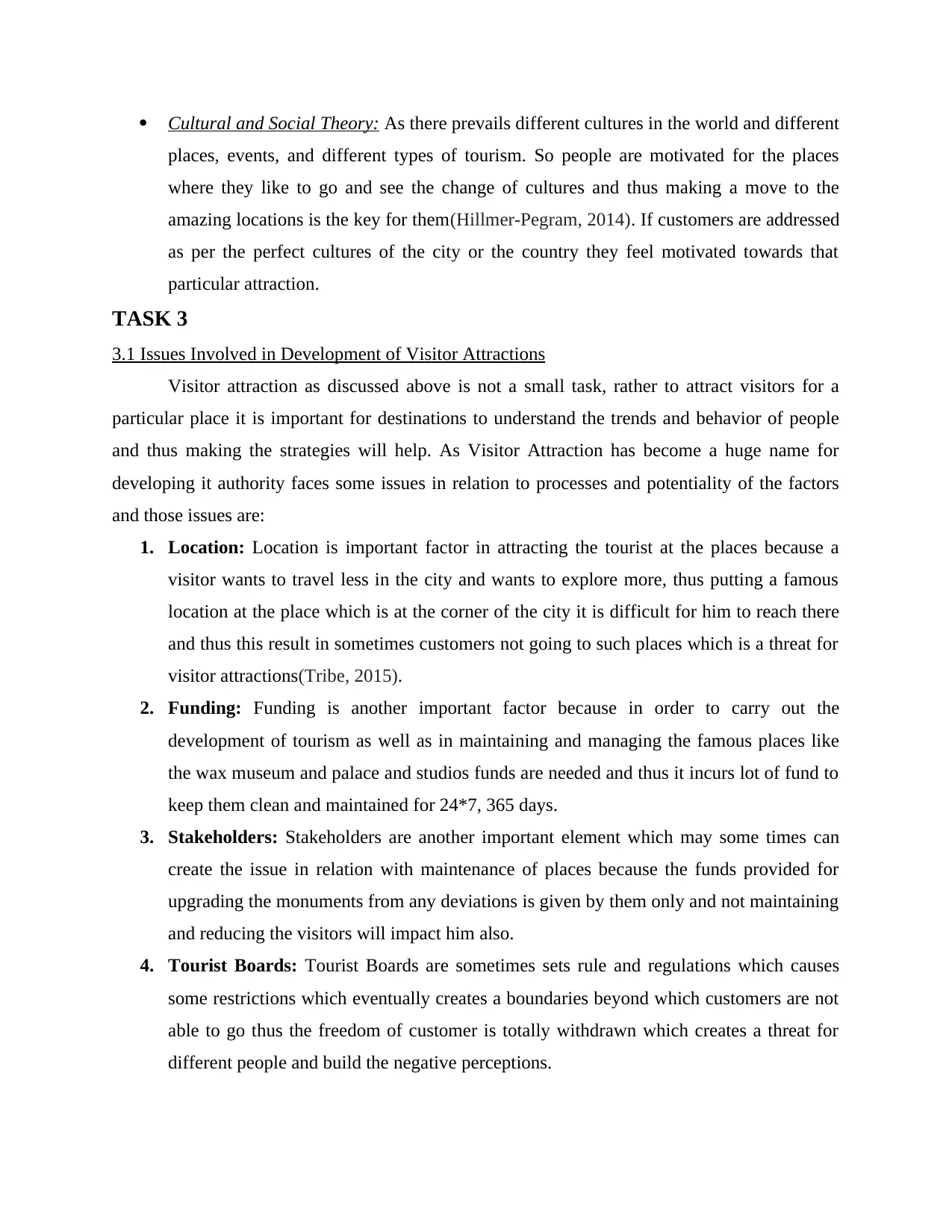
Cultural and Social Theory: As there prevails different cultures in the world and different
places, events, and different types of tourism. So people are motivated for the places
where they like to go and see the change of cultures and thus making a move to the
amazing locations is the key for them(Hillmer-Pegram, 2014). If customers are addressed
as per the perfect cultures of the city or the country they feel motivated towards that
particular attraction.
TASK 3
3.1 Issues Involved in Development of Visitor Attractions
Visitor attraction as discussed above is not a small task, rather to attract visitors for a
particular place it is important for destinations to understand the trends and behavior of people
and thus making the strategies will help. As Visitor Attraction has become a huge name for
developing it authority faces some issues in relation to processes and potentiality of the factors
and those issues are:
1. Location: Location is important factor in attracting the tourist at the places because a
visitor wants to travel less in the city and wants to explore more, thus putting a famous
location at the place which is at the corner of the city it is difficult for him to reach there
and thus this result in sometimes customers not going to such places which is a threat for
visitor attractions(Tribe, 2015).
2. Funding: Funding is another important factor because in order to carry out the
development of tourism as well as in maintaining and managing the famous places like
the wax museum and palace and studios funds are needed and thus it incurs lot of fund to
keep them clean and maintained for 24*7, 365 days.
3. Stakeholders: Stakeholders are another important element which may some times can
create the issue in relation with maintenance of places because the funds provided for
upgrading the monuments from any deviations is given by them only and not maintaining
and reducing the visitors will impact him also.
4. Tourist Boards: Tourist Boards are sometimes sets rule and regulations which causes
some restrictions which eventually creates a boundaries beyond which customers are not
able to go thus the freedom of customer is totally withdrawn which creates a threat for
different people and build the negative perceptions.
places, events, and different types of tourism. So people are motivated for the places
where they like to go and see the change of cultures and thus making a move to the
amazing locations is the key for them(Hillmer-Pegram, 2014). If customers are addressed
as per the perfect cultures of the city or the country they feel motivated towards that
particular attraction.
TASK 3
3.1 Issues Involved in Development of Visitor Attractions
Visitor attraction as discussed above is not a small task, rather to attract visitors for a
particular place it is important for destinations to understand the trends and behavior of people
and thus making the strategies will help. As Visitor Attraction has become a huge name for
developing it authority faces some issues in relation to processes and potentiality of the factors
and those issues are:
1. Location: Location is important factor in attracting the tourist at the places because a
visitor wants to travel less in the city and wants to explore more, thus putting a famous
location at the place which is at the corner of the city it is difficult for him to reach there
and thus this result in sometimes customers not going to such places which is a threat for
visitor attractions(Tribe, 2015).
2. Funding: Funding is another important factor because in order to carry out the
development of tourism as well as in maintaining and managing the famous places like
the wax museum and palace and studios funds are needed and thus it incurs lot of fund to
keep them clean and maintained for 24*7, 365 days.
3. Stakeholders: Stakeholders are another important element which may some times can
create the issue in relation with maintenance of places because the funds provided for
upgrading the monuments from any deviations is given by them only and not maintaining
and reducing the visitors will impact him also.
4. Tourist Boards: Tourist Boards are sometimes sets rule and regulations which causes
some restrictions which eventually creates a boundaries beyond which customers are not
able to go thus the freedom of customer is totally withdrawn which creates a threat for
different people and build the negative perceptions.

5. Tourism Organizations: There are different organizations like national trust, English
heritage, etc(Guttentag, 2015). These organizations in order to develop the particular
attraction put there efforts by donating amount in form of carrying out the repair works
and facilitating the services of any kind there.
6. Pressure Groups: Further Different pressure groups and other non-violence groups
creates issues on the verge of national and historic monuments are not used as tourist
destinations because they feel that they are there historic monuments which needs to be
preserved and taken care of(Lee and Brahmasrene, 2013). Giving the public to enter
those will destroy the beauty of all those monuments and places.
7. Attraction Management: Sometimes due to high traffic of people at the destinations it is
difficult for authorities to make proper arrangement of activities and thus there they lacks
and sometimes the deviations are so high which results in loosing the visitors from the
vault.
TASK 4
4.1 Analysis of different Visitor Management Strategies 400
Since there are so many issues which affect the visitors management and they can be
positive and negative also. So in order to maintain the potentiality of attractions different
management strategies that needs to be followed are:
Reduce Usage of entire Protected Area: Herein, authorities can limit the visitors in the
protected areas through which they can limit them in protection zone and that zone can be
further maintained. Also restriction or limitation on length of stay at different places will
encourage use of other areas(Guttentag, 2015). Charging a low visitor fee is the key in
making visitor attractions a place to hangout. Management require certain skills and
equipment to perform this.
Reduce Usage of Problem Areas: Herein, management should inform about the
problem areas and alternative areas and limit the number of visitors in the problem areas
because for problem solving importance is to have a area where no tourists are there. It
encourages a stay limit in problem areas. managements needs to apply tactics related to
establishing different skills and equipment requirements.
heritage, etc(Guttentag, 2015). These organizations in order to develop the particular
attraction put there efforts by donating amount in form of carrying out the repair works
and facilitating the services of any kind there.
6. Pressure Groups: Further Different pressure groups and other non-violence groups
creates issues on the verge of national and historic monuments are not used as tourist
destinations because they feel that they are there historic monuments which needs to be
preserved and taken care of(Lee and Brahmasrene, 2013). Giving the public to enter
those will destroy the beauty of all those monuments and places.
7. Attraction Management: Sometimes due to high traffic of people at the destinations it is
difficult for authorities to make proper arrangement of activities and thus there they lacks
and sometimes the deviations are so high which results in loosing the visitors from the
vault.
TASK 4
4.1 Analysis of different Visitor Management Strategies 400
Since there are so many issues which affect the visitors management and they can be
positive and negative also. So in order to maintain the potentiality of attractions different
management strategies that needs to be followed are:
Reduce Usage of entire Protected Area: Herein, authorities can limit the visitors in the
protected areas through which they can limit them in protection zone and that zone can be
further maintained. Also restriction or limitation on length of stay at different places will
encourage use of other areas(Guttentag, 2015). Charging a low visitor fee is the key in
making visitor attractions a place to hangout. Management require certain skills and
equipment to perform this.
Reduce Usage of Problem Areas: Herein, management should inform about the
problem areas and alternative areas and limit the number of visitors in the problem areas
because for problem solving importance is to have a area where no tourists are there. It
encourages a stay limit in problem areas. managements needs to apply tactics related to
establishing different skills and equipment requirements.
Secure Best Marks with AI Grader
Need help grading? Try our AI Grader for instant feedback on your assignments.
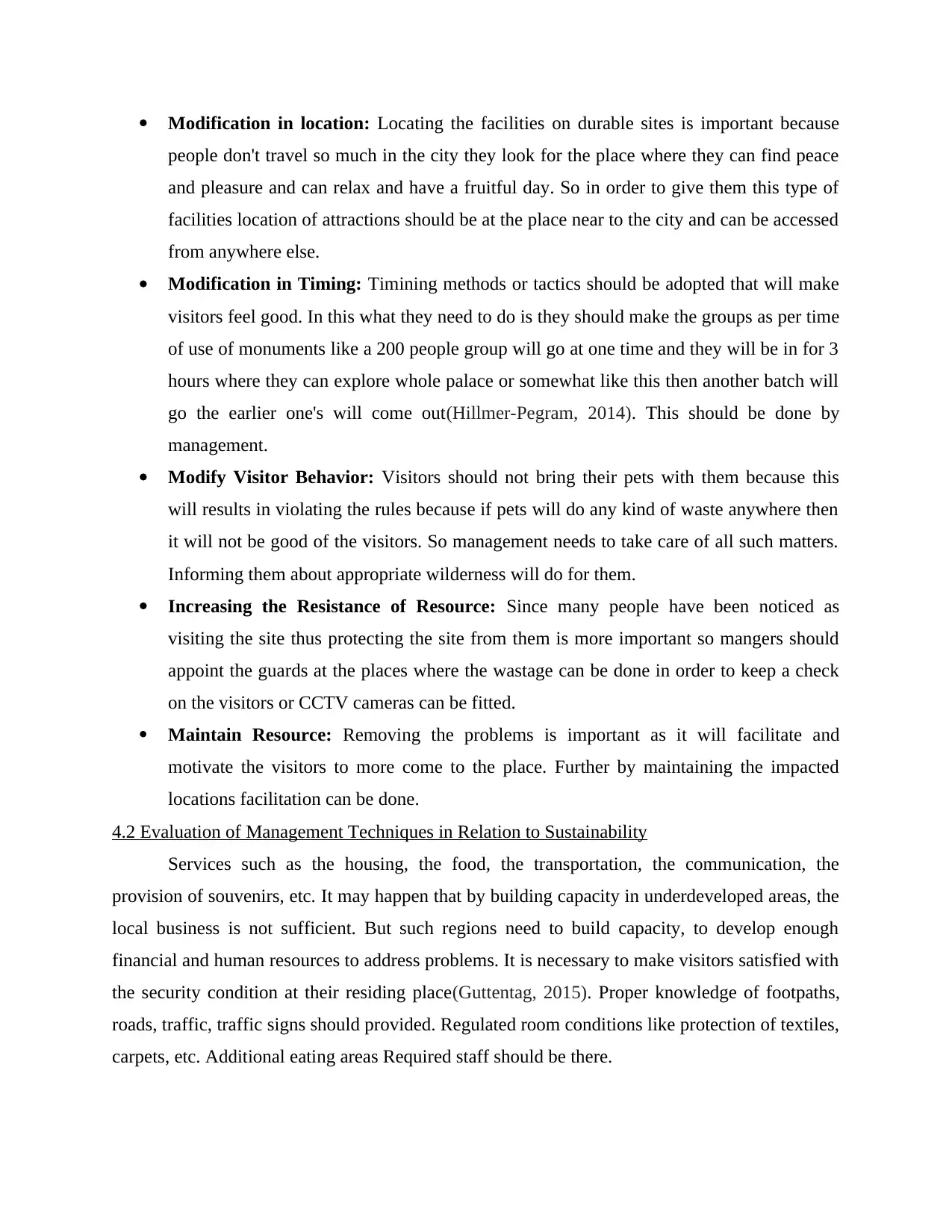
Modification in location: Locating the facilities on durable sites is important because
people don't travel so much in the city they look for the place where they can find peace
and pleasure and can relax and have a fruitful day. So in order to give them this type of
facilities location of attractions should be at the place near to the city and can be accessed
from anywhere else.
Modification in Timing: Timining methods or tactics should be adopted that will make
visitors feel good. In this what they need to do is they should make the groups as per time
of use of monuments like a 200 people group will go at one time and they will be in for 3
hours where they can explore whole palace or somewhat like this then another batch will
go the earlier one's will come out(Hillmer-Pegram, 2014). This should be done by
management.
Modify Visitor Behavior: Visitors should not bring their pets with them because this
will results in violating the rules because if pets will do any kind of waste anywhere then
it will not be good of the visitors. So management needs to take care of all such matters.
Informing them about appropriate wilderness will do for them.
Increasing the Resistance of Resource: Since many people have been noticed as
visiting the site thus protecting the site from them is more important so mangers should
appoint the guards at the places where the wastage can be done in order to keep a check
on the visitors or CCTV cameras can be fitted.
Maintain Resource: Removing the problems is important as it will facilitate and
motivate the visitors to more come to the place. Further by maintaining the impacted
locations facilitation can be done.
4.2 Evaluation of Management Techniques in Relation to Sustainability
Services such as the housing, the food, the transportation, the communication, the
provision of souvenirs, etc. It may happen that by building capacity in underdeveloped areas, the
local business is not sufficient. But such regions need to build capacity, to develop enough
financial and human resources to address problems. It is necessary to make visitors satisfied with
the security condition at their residing place(Guttentag, 2015). Proper knowledge of footpaths,
roads, traffic, traffic signs should provided. Regulated room conditions like protection of textiles,
carpets, etc. Additional eating areas Required staff should be there.
people don't travel so much in the city they look for the place where they can find peace
and pleasure and can relax and have a fruitful day. So in order to give them this type of
facilities location of attractions should be at the place near to the city and can be accessed
from anywhere else.
Modification in Timing: Timining methods or tactics should be adopted that will make
visitors feel good. In this what they need to do is they should make the groups as per time
of use of monuments like a 200 people group will go at one time and they will be in for 3
hours where they can explore whole palace or somewhat like this then another batch will
go the earlier one's will come out(Hillmer-Pegram, 2014). This should be done by
management.
Modify Visitor Behavior: Visitors should not bring their pets with them because this
will results in violating the rules because if pets will do any kind of waste anywhere then
it will not be good of the visitors. So management needs to take care of all such matters.
Informing them about appropriate wilderness will do for them.
Increasing the Resistance of Resource: Since many people have been noticed as
visiting the site thus protecting the site from them is more important so mangers should
appoint the guards at the places where the wastage can be done in order to keep a check
on the visitors or CCTV cameras can be fitted.
Maintain Resource: Removing the problems is important as it will facilitate and
motivate the visitors to more come to the place. Further by maintaining the impacted
locations facilitation can be done.
4.2 Evaluation of Management Techniques in Relation to Sustainability
Services such as the housing, the food, the transportation, the communication, the
provision of souvenirs, etc. It may happen that by building capacity in underdeveloped areas, the
local business is not sufficient. But such regions need to build capacity, to develop enough
financial and human resources to address problems. It is necessary to make visitors satisfied with
the security condition at their residing place(Guttentag, 2015). Proper knowledge of footpaths,
roads, traffic, traffic signs should provided. Regulated room conditions like protection of textiles,
carpets, etc. Additional eating areas Required staff should be there.
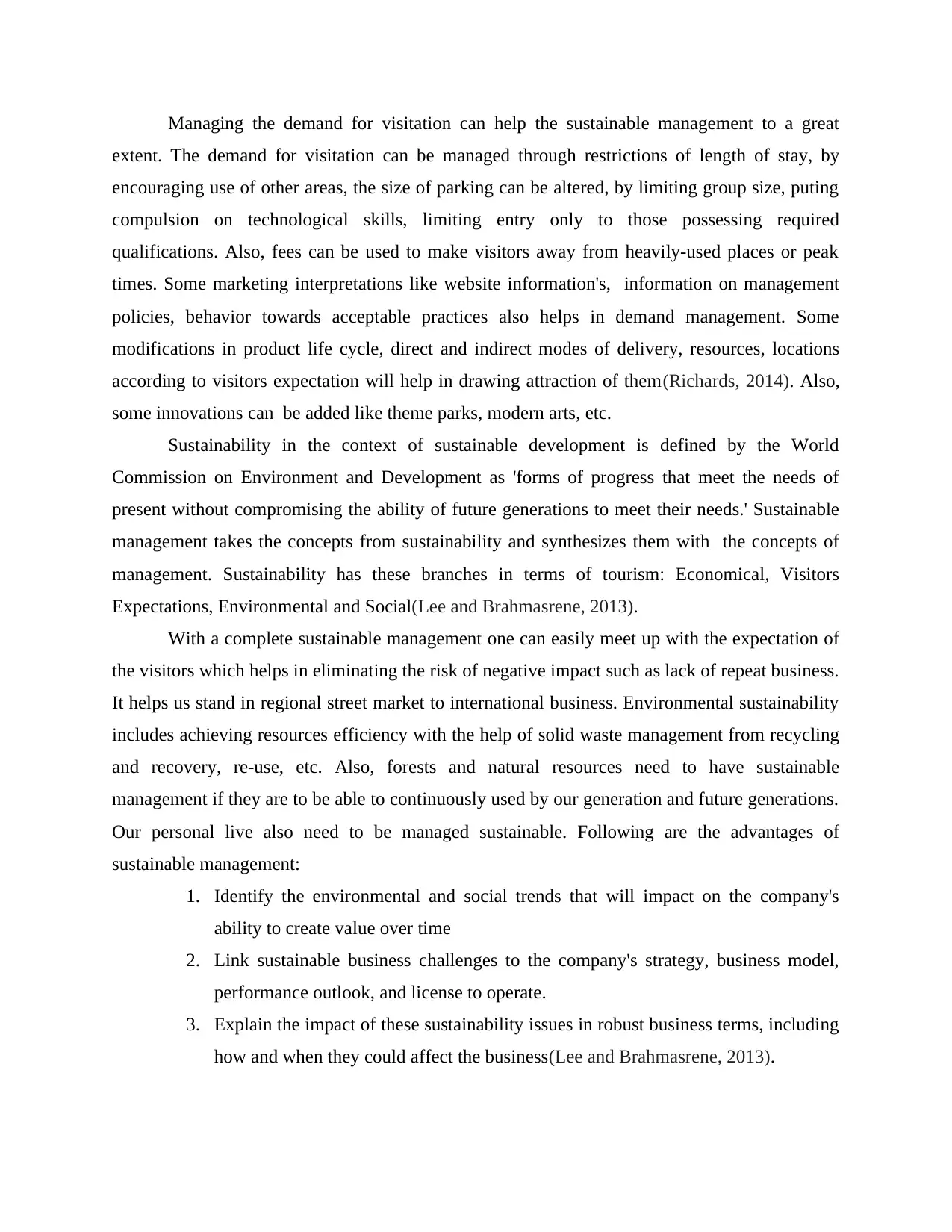
Managing the demand for visitation can help the sustainable management to a great
extent. The demand for visitation can be managed through restrictions of length of stay, by
encouraging use of other areas, the size of parking can be altered, by limiting group size, puting
compulsion on technological skills, limiting entry only to those possessing required
qualifications. Also, fees can be used to make visitors away from heavily-used places or peak
times. Some marketing interpretations like website information's, information on management
policies, behavior towards acceptable practices also helps in demand management. Some
modifications in product life cycle, direct and indirect modes of delivery, resources, locations
according to visitors expectation will help in drawing attraction of them(Richards, 2014). Also,
some innovations can be added like theme parks, modern arts, etc.
Sustainability in the context of sustainable development is defined by the World
Commission on Environment and Development as 'forms of progress that meet the needs of
present without compromising the ability of future generations to meet their needs.' Sustainable
management takes the concepts from sustainability and synthesizes them with the concepts of
management. Sustainability has these branches in terms of tourism: Economical, Visitors
Expectations, Environmental and Social(Lee and Brahmasrene, 2013).
With a complete sustainable management one can easily meet up with the expectation of
the visitors which helps in eliminating the risk of negative impact such as lack of repeat business.
It helps us stand in regional street market to international business. Environmental sustainability
includes achieving resources efficiency with the help of solid waste management from recycling
and recovery, re-use, etc. Also, forests and natural resources need to have sustainable
management if they are to be able to continuously used by our generation and future generations.
Our personal live also need to be managed sustainable. Following are the advantages of
sustainable management:
1. Identify the environmental and social trends that will impact on the company's
ability to create value over time
2. Link sustainable business challenges to the company's strategy, business model,
performance outlook, and license to operate.
3. Explain the impact of these sustainability issues in robust business terms, including
how and when they could affect the business(Lee and Brahmasrene, 2013).
extent. The demand for visitation can be managed through restrictions of length of stay, by
encouraging use of other areas, the size of parking can be altered, by limiting group size, puting
compulsion on technological skills, limiting entry only to those possessing required
qualifications. Also, fees can be used to make visitors away from heavily-used places or peak
times. Some marketing interpretations like website information's, information on management
policies, behavior towards acceptable practices also helps in demand management. Some
modifications in product life cycle, direct and indirect modes of delivery, resources, locations
according to visitors expectation will help in drawing attraction of them(Richards, 2014). Also,
some innovations can be added like theme parks, modern arts, etc.
Sustainability in the context of sustainable development is defined by the World
Commission on Environment and Development as 'forms of progress that meet the needs of
present without compromising the ability of future generations to meet their needs.' Sustainable
management takes the concepts from sustainability and synthesizes them with the concepts of
management. Sustainability has these branches in terms of tourism: Economical, Visitors
Expectations, Environmental and Social(Lee and Brahmasrene, 2013).
With a complete sustainable management one can easily meet up with the expectation of
the visitors which helps in eliminating the risk of negative impact such as lack of repeat business.
It helps us stand in regional street market to international business. Environmental sustainability
includes achieving resources efficiency with the help of solid waste management from recycling
and recovery, re-use, etc. Also, forests and natural resources need to have sustainable
management if they are to be able to continuously used by our generation and future generations.
Our personal live also need to be managed sustainable. Following are the advantages of
sustainable management:
1. Identify the environmental and social trends that will impact on the company's
ability to create value over time
2. Link sustainable business challenges to the company's strategy, business model,
performance outlook, and license to operate.
3. Explain the impact of these sustainability issues in robust business terms, including
how and when they could affect the business(Lee and Brahmasrene, 2013).
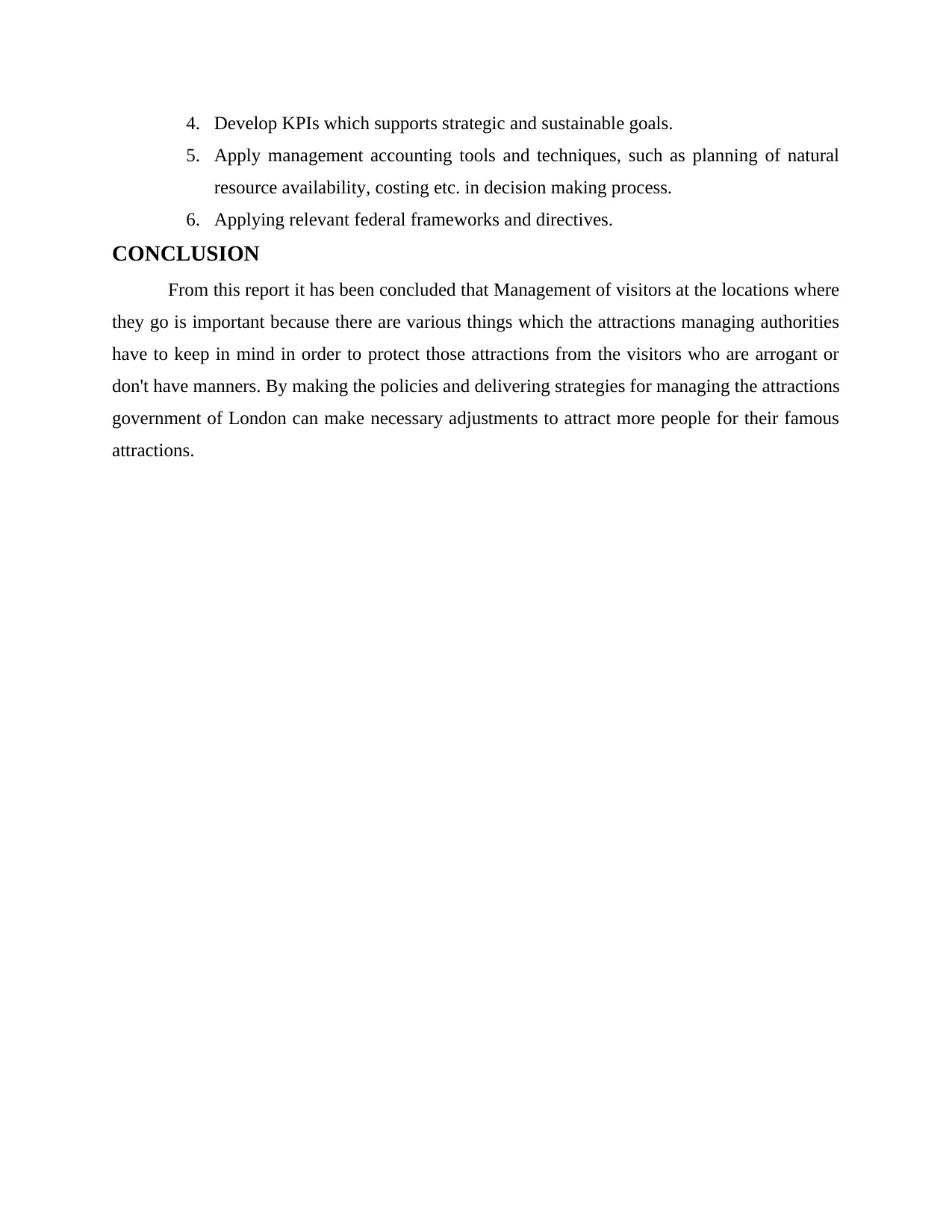
4. Develop KPIs which supports strategic and sustainable goals.
5. Apply management accounting tools and techniques, such as planning of natural
resource availability, costing etc. in decision making process.
6. Applying relevant federal frameworks and directives.
CONCLUSION
From this report it has been concluded that Management of visitors at the locations where
they go is important because there are various things which the attractions managing authorities
have to keep in mind in order to protect those attractions from the visitors who are arrogant or
don't have manners. By making the policies and delivering strategies for managing the attractions
government of London can make necessary adjustments to attract more people for their famous
attractions.
5. Apply management accounting tools and techniques, such as planning of natural
resource availability, costing etc. in decision making process.
6. Applying relevant federal frameworks and directives.
CONCLUSION
From this report it has been concluded that Management of visitors at the locations where
they go is important because there are various things which the attractions managing authorities
have to keep in mind in order to protect those attractions from the visitors who are arrogant or
don't have manners. By making the policies and delivering strategies for managing the attractions
government of London can make necessary adjustments to attract more people for their famous
attractions.
Paraphrase This Document
Need a fresh take? Get an instant paraphrase of this document with our AI Paraphraser
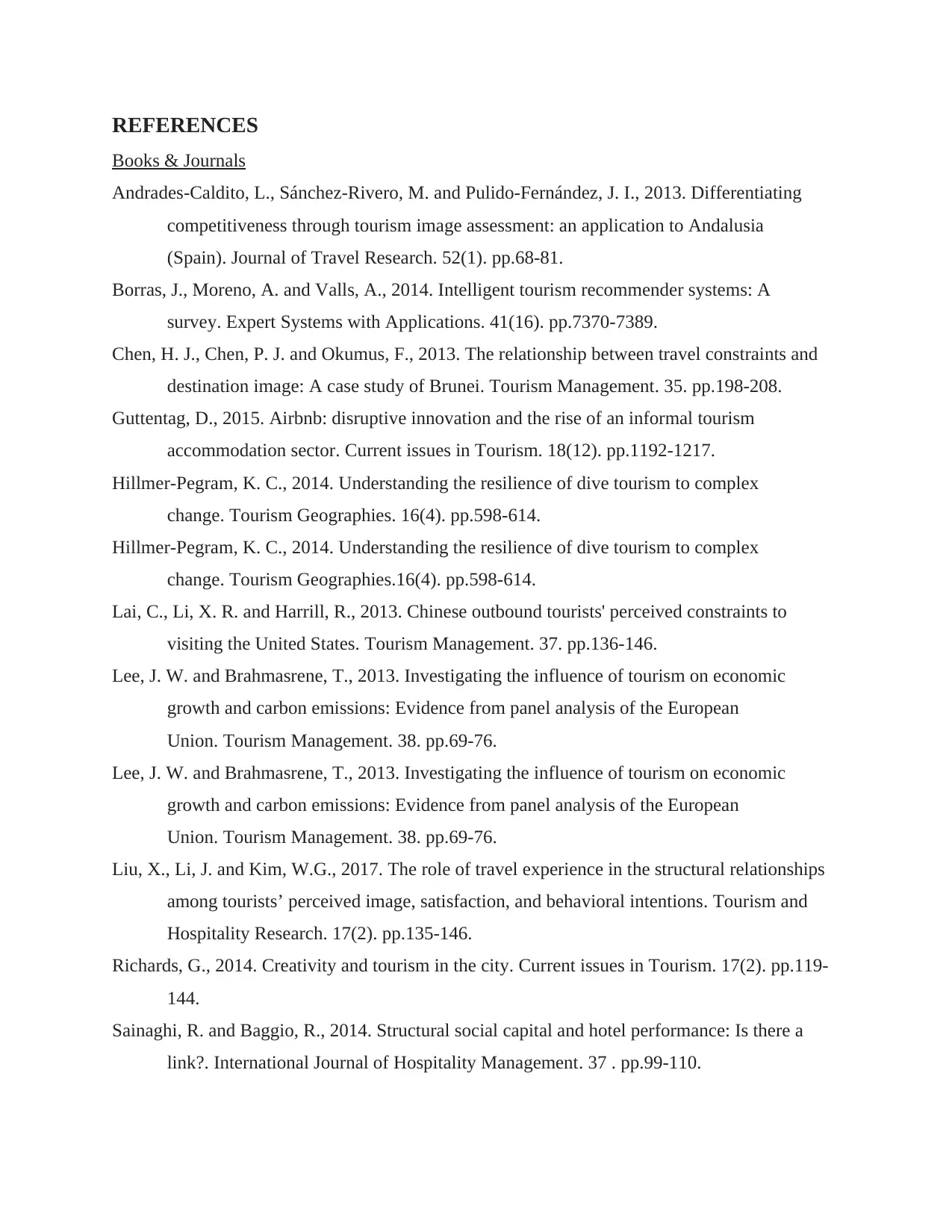
REFERENCES
Books & Journals
Andrades-Caldito, L., Sánchez-Rivero, M. and Pulido-Fernández, J. I., 2013. Differentiating
competitiveness through tourism image assessment: an application to Andalusia
(Spain). Journal of Travel Research. 52(1). pp.68-81.
Borras, J., Moreno, A. and Valls, A., 2014. Intelligent tourism recommender systems: A
survey. Expert Systems with Applications. 41(16). pp.7370-7389.
Chen, H. J., Chen, P. J. and Okumus, F., 2013. The relationship between travel constraints and
destination image: A case study of Brunei. Tourism Management. 35. pp.198-208.
Guttentag, D., 2015. Airbnb: disruptive innovation and the rise of an informal tourism
accommodation sector. Current issues in Tourism. 18(12). pp.1192-1217.
Hillmer-Pegram, K. C., 2014. Understanding the resilience of dive tourism to complex
change. Tourism Geographies. 16(4). pp.598-614.
Hillmer-Pegram, K. C., 2014. Understanding the resilience of dive tourism to complex
change. Tourism Geographies.16(4). pp.598-614.
Lai, C., Li, X. R. and Harrill, R., 2013. Chinese outbound tourists' perceived constraints to
visiting the United States. Tourism Management. 37. pp.136-146.
Lee, J. W. and Brahmasrene, T., 2013. Investigating the influence of tourism on economic
growth and carbon emissions: Evidence from panel analysis of the European
Union. Tourism Management. 38. pp.69-76.
Lee, J. W. and Brahmasrene, T., 2013. Investigating the influence of tourism on economic
growth and carbon emissions: Evidence from panel analysis of the European
Union. Tourism Management. 38. pp.69-76.
Liu, X., Li, J. and Kim, W.G., 2017. The role of travel experience in the structural relationships
among tourists’ perceived image, satisfaction, and behavioral intentions. Tourism and
Hospitality Research. 17(2). pp.135-146.
Richards, G., 2014. Creativity and tourism in the city. Current issues in Tourism. 17(2). pp.119-
144.
Sainaghi, R. and Baggio, R., 2014. Structural social capital and hotel performance: Is there a
link?. International Journal of Hospitality Management. 37 . pp.99-110.
Books & Journals
Andrades-Caldito, L., Sánchez-Rivero, M. and Pulido-Fernández, J. I., 2013. Differentiating
competitiveness through tourism image assessment: an application to Andalusia
(Spain). Journal of Travel Research. 52(1). pp.68-81.
Borras, J., Moreno, A. and Valls, A., 2014. Intelligent tourism recommender systems: A
survey. Expert Systems with Applications. 41(16). pp.7370-7389.
Chen, H. J., Chen, P. J. and Okumus, F., 2013. The relationship between travel constraints and
destination image: A case study of Brunei. Tourism Management. 35. pp.198-208.
Guttentag, D., 2015. Airbnb: disruptive innovation and the rise of an informal tourism
accommodation sector. Current issues in Tourism. 18(12). pp.1192-1217.
Hillmer-Pegram, K. C., 2014. Understanding the resilience of dive tourism to complex
change. Tourism Geographies. 16(4). pp.598-614.
Hillmer-Pegram, K. C., 2014. Understanding the resilience of dive tourism to complex
change. Tourism Geographies.16(4). pp.598-614.
Lai, C., Li, X. R. and Harrill, R., 2013. Chinese outbound tourists' perceived constraints to
visiting the United States. Tourism Management. 37. pp.136-146.
Lee, J. W. and Brahmasrene, T., 2013. Investigating the influence of tourism on economic
growth and carbon emissions: Evidence from panel analysis of the European
Union. Tourism Management. 38. pp.69-76.
Lee, J. W. and Brahmasrene, T., 2013. Investigating the influence of tourism on economic
growth and carbon emissions: Evidence from panel analysis of the European
Union. Tourism Management. 38. pp.69-76.
Liu, X., Li, J. and Kim, W.G., 2017. The role of travel experience in the structural relationships
among tourists’ perceived image, satisfaction, and behavioral intentions. Tourism and
Hospitality Research. 17(2). pp.135-146.
Richards, G., 2014. Creativity and tourism in the city. Current issues in Tourism. 17(2). pp.119-
144.
Sainaghi, R. and Baggio, R., 2014. Structural social capital and hotel performance: Is there a
link?. International Journal of Hospitality Management. 37 . pp.99-110.
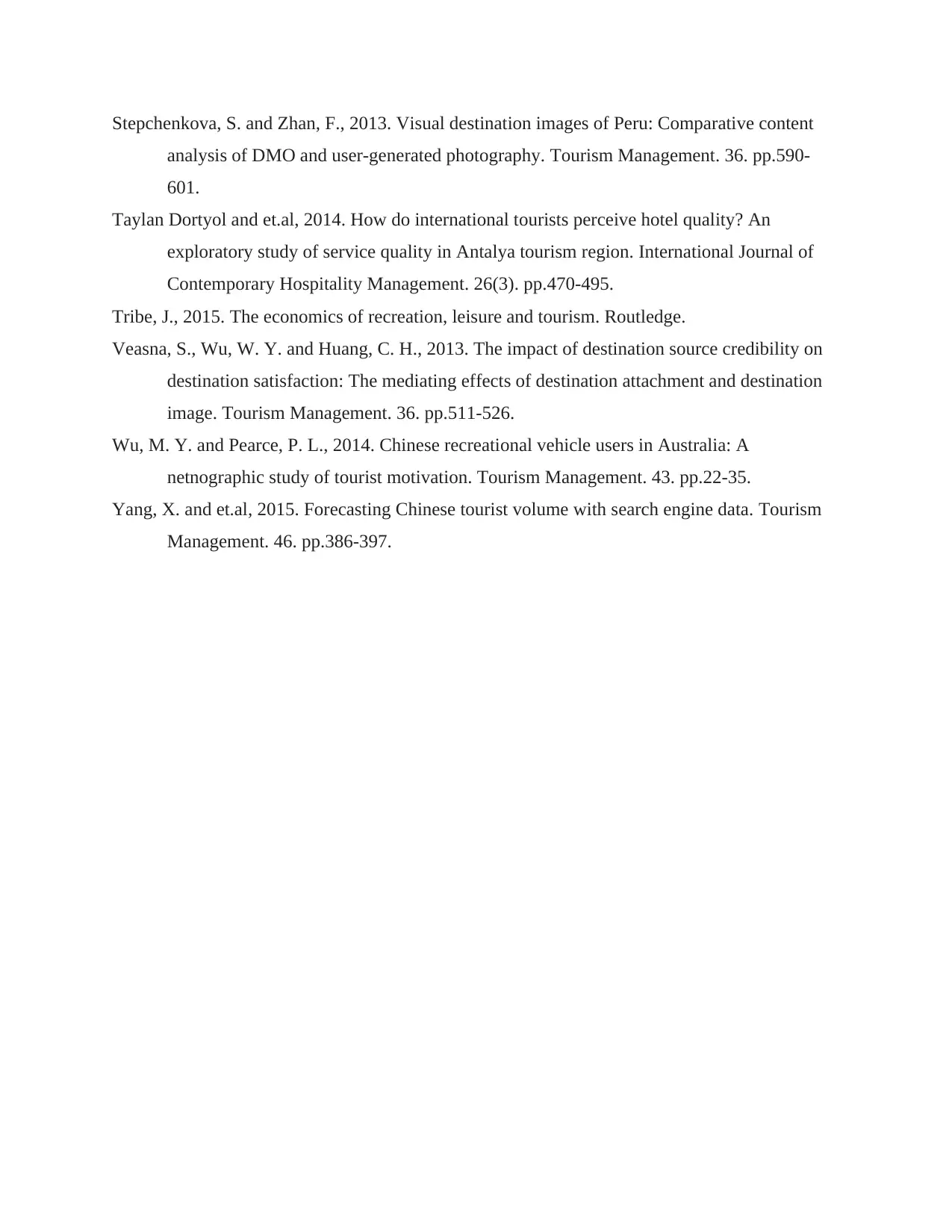
Stepchenkova, S. and Zhan, F., 2013. Visual destination images of Peru: Comparative content
analysis of DMO and user-generated photography. Tourism Management. 36. pp.590-
601.
Taylan Dortyol and et.al, 2014. How do international tourists perceive hotel quality? An
exploratory study of service quality in Antalya tourism region. International Journal of
Contemporary Hospitality Management. 26(3). pp.470-495.
Tribe, J., 2015. The economics of recreation, leisure and tourism. Routledge.
Veasna, S., Wu, W. Y. and Huang, C. H., 2013. The impact of destination source credibility on
destination satisfaction: The mediating effects of destination attachment and destination
image. Tourism Management. 36. pp.511-526.
Wu, M. Y. and Pearce, P. L., 2014. Chinese recreational vehicle users in Australia: A
netnographic study of tourist motivation. Tourism Management. 43. pp.22-35.
Yang, X. and et.al, 2015. Forecasting Chinese tourist volume with search engine data. Tourism
Management. 46. pp.386-397.
analysis of DMO and user-generated photography. Tourism Management. 36. pp.590-
601.
Taylan Dortyol and et.al, 2014. How do international tourists perceive hotel quality? An
exploratory study of service quality in Antalya tourism region. International Journal of
Contemporary Hospitality Management. 26(3). pp.470-495.
Tribe, J., 2015. The economics of recreation, leisure and tourism. Routledge.
Veasna, S., Wu, W. Y. and Huang, C. H., 2013. The impact of destination source credibility on
destination satisfaction: The mediating effects of destination attachment and destination
image. Tourism Management. 36. pp.511-526.
Wu, M. Y. and Pearce, P. L., 2014. Chinese recreational vehicle users in Australia: A
netnographic study of tourist motivation. Tourism Management. 43. pp.22-35.
Yang, X. and et.al, 2015. Forecasting Chinese tourist volume with search engine data. Tourism
Management. 46. pp.386-397.
1 out of 15
Related Documents
Your All-in-One AI-Powered Toolkit for Academic Success.
+13062052269
info@desklib.com
Available 24*7 on WhatsApp / Email
![[object Object]](/_next/static/media/star-bottom.7253800d.svg)
Unlock your academic potential
© 2024 | Zucol Services PVT LTD | All rights reserved.





